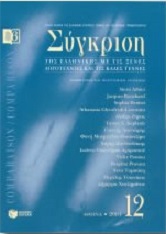Pulcinella and inquisition's victim: two personae dramatis of the end of the 18th century
Abstract
Although Goya's Caprichos (1799) have been thoroughly studied, the influence of the Tiepolos on their thematic choices has seldom been acknowledged, if not ignored. This paper deals with some unexamined aspects regarding the relation between the imagery of the Caprichos of Francisco Goya (1746-1828) and that of the Divertimenti per li Regazzi (1797-99) of Domenico Tiepolo (1727-1804) —son of the famous Venetian painter, Giambattista Tiepolo (1692-1770). Through the inherently fascinating carnival figure of Pulcinella, Domenico Tiepolo offers an insight into the artistic values which the histrionic manifestations of life might have, while Goya unfolds the ambivalence of mundus inversus through a sequence of theatrically disposed incidents. Goya, during his sojourn in Venice, which has been recently ascertained, denotes the significance of the ritual of the famous carnival —the most theatrical of social performances. We suggest that both figures of Pulcinella and of an emblematic anonymous victim of the Spanish Inquisition entail moral irony and mockery in order to criticize their era, and we bring to light their common «misruling» and insistently un-rational conduct.
Article Details
- How to Cite
-
Μουμτζίδου-Παπατζίμα Φ. (2017). Pulcinella and inquisition’s victim: two personae dramatis of the end of the 18th century. Comparison, 12, 118–141. https://doi.org/10.12681/comparison.10812
- Issue
- Vol. 12 (2001)
- Section
- Articles

This work is licensed under a Creative Commons Attribution-NonCommercial-ShareAlike 4.0 International License.
Authors who publish with this journal agree to the following terms:
- Authors retain copyright and grant the journal right of first publication with the work simultaneously licensed under a Creative Commons Attribution Non-Commercial License that allows others to share the work with an acknowledgement of the work's authorship and initial publication in this journal.
- Authors are able to enter into separate, additional contractual arrangements for the non-exclusive distribution of the journal's published version of the work (e.g. post it to an institutional repository or publish it in a book), with an acknowledgement of its initial publication in this journal.
- Authors are permitted and encouraged to post their work online (preferably in institutional repositories or on their website) prior to and during the submission process, as it can lead to productive exchanges, as well as earlier and greater citation of published work (See The Effect of Open Access).
Downloads
Download data is not yet available.



